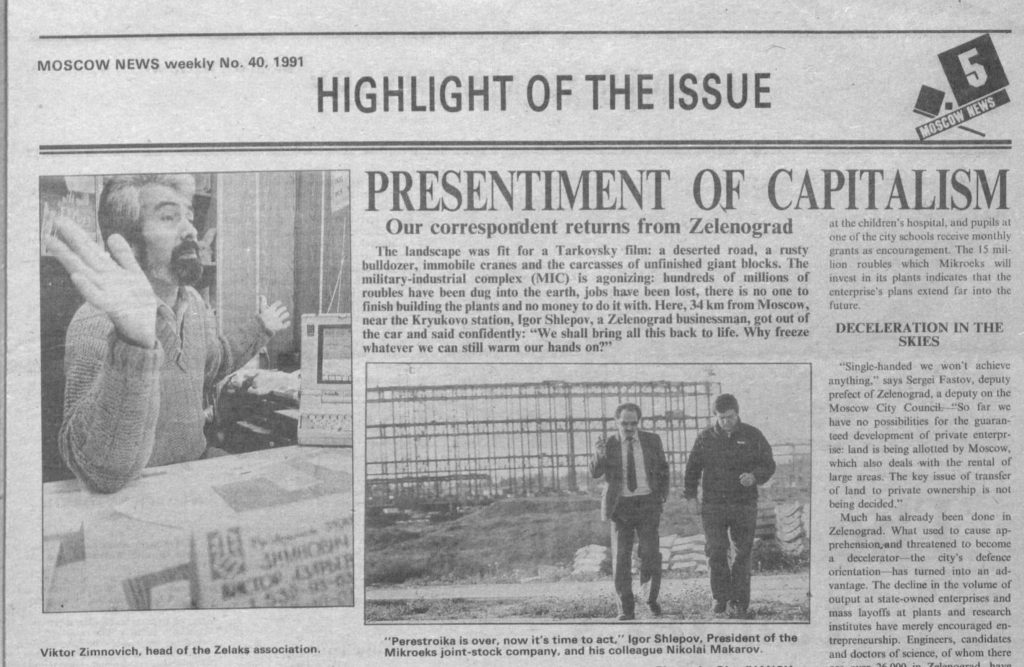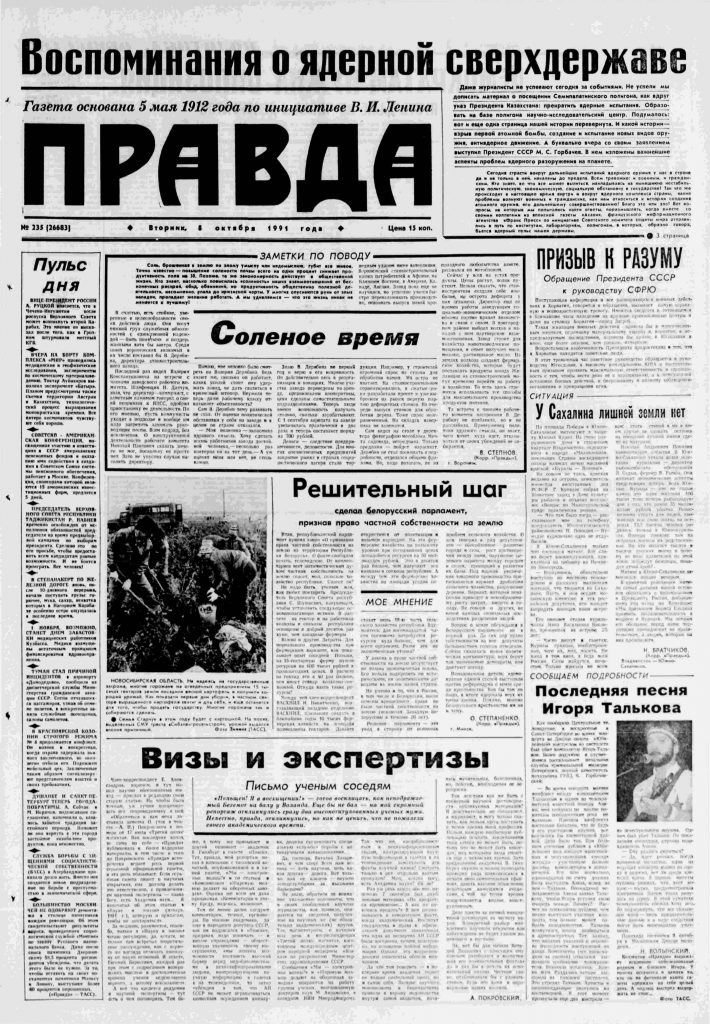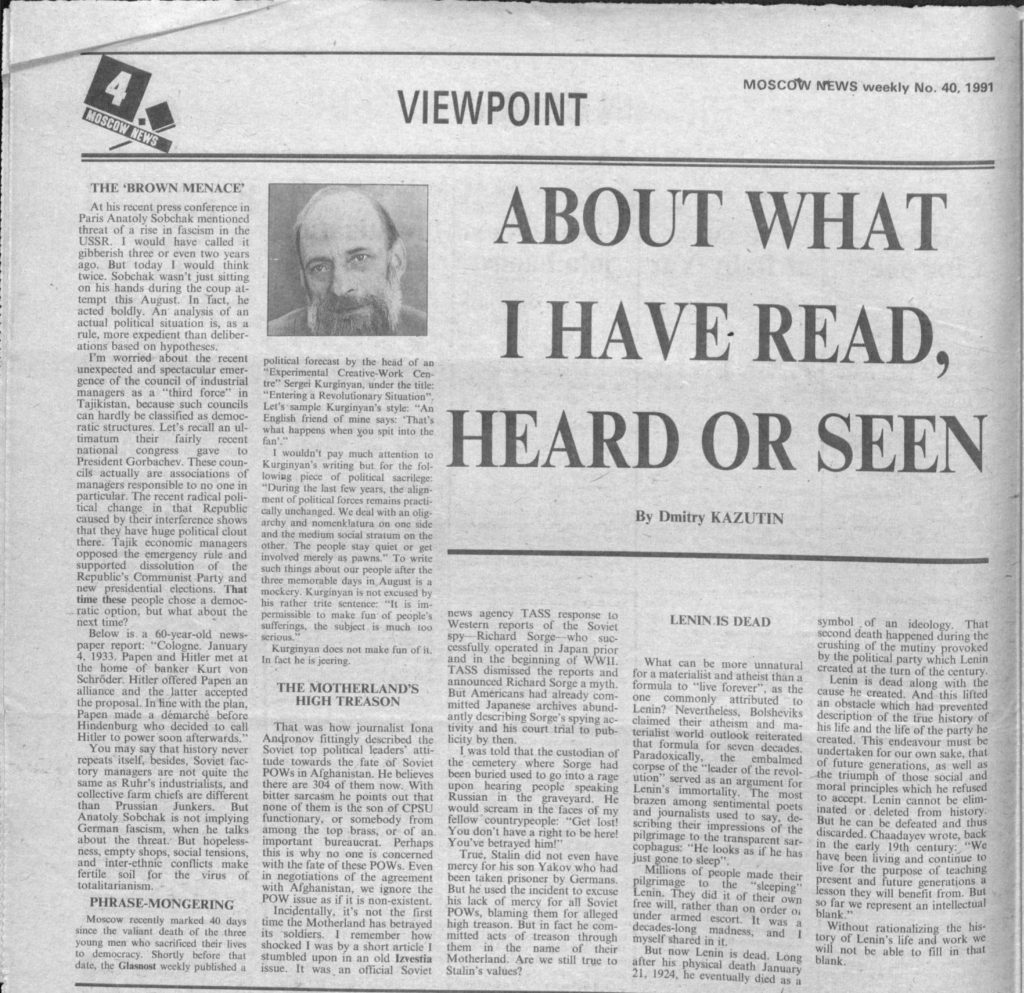By Colton Powaski
By the week of October 6, 1991, it was obvious that the Soviet Union was collapsing. However, what was to come next still remained uncertain. The front page of the English-language Moscow News contained a picture of the fallen Lenin statue in Dushanbe, Tajikistan with the headline, “A Crushed Credo?” and the description, “statues crumble, the system clings on.”
Some of the articles in this Moscow News issue pointed to a more democratic and market-oriented future. Three articles within the first three pages of the Moscow News cover new free market or democratic initiatives. One reported on the privatization of the Uralmashzavod production association while a second covered the meeting of the Congress of Stock Exchanges in Kyrgyzstan.
The fifth page of the newspaper featured a long article titled, “Presentment of Capitalism.” Alexander Fyodorov, a Moscow News correspondent, interviewed businessmen in Zelenograd, a planned city near Moscow, about their thoughts on current economic and political conditions. Igor Shlepov, president of the Mikrotes stock-exchange company, said, “Perestroika is over, now is the time to act,” referencing new economic activities being undertaken by companies around the country. When asked by Fydorov what policies they would like to see, “replies were much the same: normal laws, a stable and well-considered taxation policy in the interests of the market.”
Other media outlets took up similar themes. The front page of the October 8 edition of Pravda continued the story of transition to a free market economy. An article titled, “The Decisive Step” discusses the Belarussian parliament recognizing private ownership of land, a major step towards a capitalist economy. It seems Soviet readers could not escape the bombardment of news regarding transitions towards a market economy, no matter what media they consumed.
While many articles in the week’s Moscow News focused on capitalism and the possible introduction of freer markets, one article by Dmitry Kazutin titled, “About What I Have Read, Heard, or Seen,” contains a much different tone. In it, Kazutin expressed concern that the Soviet Union’s disintegration may lead to facism or totalitarianism due to economic downturn and ethnic tensions. Kazutin compares the situation in Tajikistan to the beginnings of Hitler’s rise to power. “Hopelessness, empty shops, social tensions,and inter-ethnic conflicts make fertile soil for the virus of totalitarianism,” Kazutin wrote. Reading this article 30 years after it was written, we can see that though facism did not rise out of the ashes of the Soviet Union, liberal democracy certainly did not thrive as many had been hopeful for.
The aforementioned statement featured on the front page of the Moscow News, “statues crumble, the system clings on” sums up the week of October 2-8, 1991 quite well. The Soviet Union still lived, but barely, for its eventual death was obvious to many. Any widespread belief in something that resembled the Soviet Union of the past ceased to exist, and articles focused on the questions that many readers had, ‘What’s next?’ While a free market and liberal democracy seemed to be the popular topics at the time, with many articles discussing ongoing privatization and many opinion pieces supporting this transition, other pieces, such as Kazutin’s expressed concern that authoritarianism might fill the power vacuum.
Colton Powaski is a junior majoring in Russian, East European, and Eurasian Studies and International Studies.
References
(1991, October 8). Page 1. Pravda. Retrieved from
https://dlib-eastview-com.proxy.lib.miamioh.edu/browse/doc/21571103
(1991, October 6). Pages 1-6. Moscow News Digital Archive. Retrieved from
https://dlib-eastview-com.proxy.lib.miamioh.edu/browse/doc/49796712




